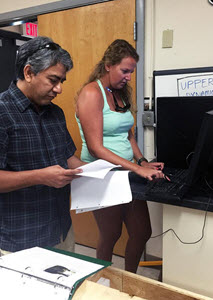
Senior research associate Jodi Brewster (left) and Ph.D. candidate Johna Rudzin (right) deploying a CTD with Nanson bottles off the University of Miami R/V F. G. Walton Smith, a ship in the University-National Oceanographic Laboratory System fleet. (Photo by Jodi Brewster).
As the Deepwater Horizon oil spill unfolded, there were concerns that the Loop Current might transport oil out of the Gulf to the Florida Keys and up the eastern seaboard. This possibility highlighted the need for quick predictions of oceanic flows and subsurface hydrocarbon distribution during and after a spill. Because physical and biochemical processes can alter subsurface hydrocarbons’ chemical composition and behavior, a successful modeling system must account for these processes when predicting oil fate.
The Gulf of Mexico Research Initiative (GoMRI) recently awarded Dr. Lynn “Nick” Shay a grant to develop an integrated physical and biogeochemical observation and prediction system to map the near-real-time distribution of subsurface hydrocarbons and quantify hydrocarbon fate as oil interacts with currents and sinking marine particles. Their goal is to build an observational system that researchers can easily deploy from ships and/or aircraft to start immediate sampling and begin running model scenarios for future oil spills.
The proposed system is a cluster of ten electromagnetic Autonomous Profiling Explorer (APEX) floats with physical, chemical and bio-optical sensors that provide information to a data-assimilative physical-biogeochemical model for hindcast, nowcast, and forecast simulations of oil transport and fate. The team will equip the floats with a novel combination of CTD and electromagnetic current sensors and oxygen, chlorophyll, and colored dissolved organic matter fluorescence and backscatter sensors. The system will focus on the accurate representation of mid-water column processes, including the interaction of hydrocarbon droplets with marine particles.

Prior to deployment, Johna Rudzin (right) and assistant research scientist Benjamin Jaimes (left) test the profiling parameters of an air-deployable EM/Apex float in a Rosenstiel School of Marine and Atmospheric Science laboratory. (Photo by Jodi Brewster).
“These floats have been used in the field for shipboard and aircraft deployments during hurricanes and can readily withstand major ocean and atmospheric stressors,” said Shay. “These profilers were designed to profile to depths of 2,000 m at intervals of 4 – 7 days, depending on the ocean and atmosphere conditions. That means if a hurricane is moving over the Gulf, for example, we can program the floats to sample faster and examine the effects of strong wind-driven currents and upwelling on these biochemical processes.”
The researchers will perform data-assimilative model simulations to hindcast circulation during Deepwater Horizon and determine optimal deployment strategies for field testing the floats. They will then deploy the floats in the northern Gulf from Summer 2017 to Spring 2018 to assess its skill during energetic physical processes, such as the Loop Current and atmospheric events, including hurricane season (summer) and atmospheric frontal passages (winter).
The team will assess the system’s performance using profiler metrics such as temperature, current, and salinity taken pre-, during-, and after weather events. They will also assess the system’s performance using data gathered during and after Deepwater Horizon by other GoMRI projects and the National Oceanic and Atmospheric Administration (NOAA). They will then evaluate and improve the model’s representation of mid-water column particle distributions and fluxes, accounting explicitly for marine particles interacting with oil droplets. Finally, they will validate the system’s capability for real-time, end-to-end nowcasting and forecasting by assimilating physical and biochemical satellite and float observations in near-real-time and assessing the system’s predictive skill.
Shay explained that the products created by this research will make both academic and societal contributions, “Scientifically, we hope to show how the physical stressors affect these biogeochemical processes. Societally, we hope to provide the community with an easily deployable end-to-end system product that returns real-time data to help emergency responders and policy makers to mitigate deep-sea oil spills like Deepwater Horizon.”
The project’s researchers are Lynn “Nick” Shay at the University of Miami, Katja Fennel at Dalhousie University, Peter Furze at Teledyne Webb Research, and Ruoying He at North Carolina State University. Their project is Three-Dimensional Gulf Circulation and Biogeochemical Processes Unveiled by State-of-the-Art Profiling Float Technology and Data Assimilative Ocean Models.
************
The Gulf of Mexico Research Initiative (GoMRI) is a 10-year independent research program established to study the effect, and the potential associated impact, of hydrocarbon releases on the environment and public health, as well as to develop improved spill mitigation, oil detection, characterization and remediation technologies. An independent and academic 20-member Research Board makes the funding and research direction decisions to ensure the intellectual quality, effectiveness and academic independence of the GoMRI research. All research data, findings and publications will be made publicly available. The program was established through a $500 million financial commitment from BP. For more information, visit http://gulfresearchinitiative.org/.
© Copyright 2010- 2017 Gulf of Mexico Research Initiative (GoMRI) – All Rights Reserved. Redistribution is encouraged with acknowledgement to the Gulf of Mexico Research Initiative (GoMRI). Please credit images and/or videos as done in each article. Questions? Contact web-content editor Nilde “Maggie” Dannreuther, Northern Gulf Institute, Mississippi State University (maggied@ngi.msstate.edu).
